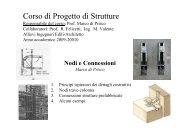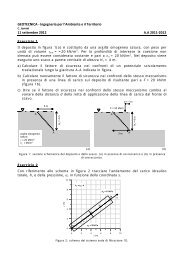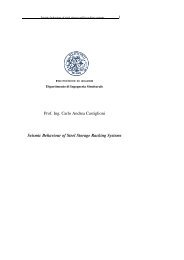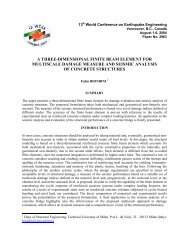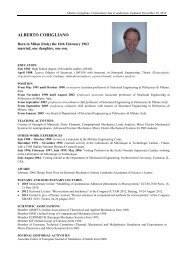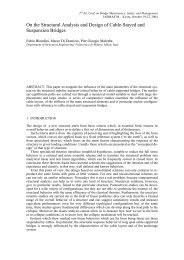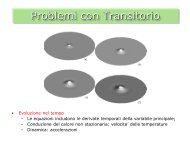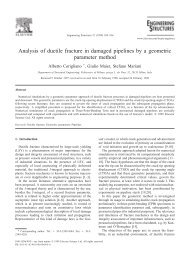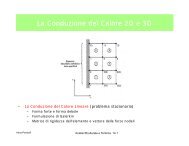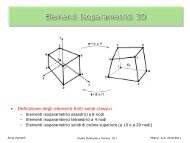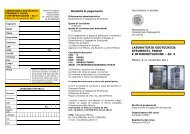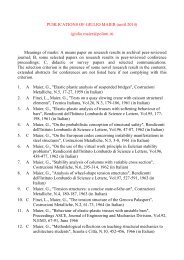Crosta and di Prisco 1071Fig. 15. Plan sketch of the intersection of saturated zonesunderneath three sets of superficial incisions. Flow localization isshown at three successive time steps t 1 , t 2 , and t 3 .of the groundwater table are shown together with the initialand final bulb profiles in Fig. 14.If we now reinterpret the actual <strong>seepage</strong> within theGroppello <strong>slope</strong> <strong>by</strong> taking into consideration the experimentalobservations, we may describe the final geometry of thesaturated domain within the <strong>slope</strong> caused <strong>by</strong> multiple watersources (three pairs of superficial incisions) as shown schematicallyin Fig. 14. As previously observed, toe <strong>erosion</strong>took place only in a narrow zone above the exit point A. The3D evolution of the saturated domain (ellipses at times t 1 –t 3in Fig. 15) was likely to be influenced <strong>by</strong> the localized flowat point A, which could explain the elongated shape of thefinal failure mechanism (ellipse at t 3 in Fig. 15). As observedin the 2D model (Fig. 12a), the shape of the saturateddomain changes when <strong>slope</strong> boundaries are reached. Asshown in the 3D representation (Fig. 16) the saturated bulbbecomes more and more narrow and elongated with time towardthe drainage boundary when <strong>seepage</strong> reaches the toe ofthe <strong>slope</strong>.Soil liquefactionThe hydraulic aspects of the phenomenon were discussedin the previous sections. In this section some hypotheses willbe inferred about the <strong>slope</strong> failure. First, the <strong>slope</strong> is veryclose to limit equilibrium, because of its inclination of 30–32°. More critical conditions could have been reached becauseof the infiltration from the water ponding on top of theterrace and the consequent saturation of the <strong>slope</strong> material.<strong>On</strong>e or more successive shallow <strong>slope</strong> failures could have occurred,creating <strong>slope</strong> concavities (Fig. 16) and exposingzones of higher permeability, thus inducing a subsequentflow confluence. Several limit-equilibrium analyses wereperformed in two dimensions using the SLOPE/W software(Geo-Slope International Ltd. 1996b) and results of the flowFig. 16. Three-dimensional sketch of transient saturated fronts and sequential <strong>slope</strong> failures (see shaded volumes and failure surfacesnumbered 1–5), mainly limited to the highly saturated <strong>slope</strong> sector below the water point sources. wt, water table.© 1999 NRC Canada
1072 Can. J. Geotech. Vol. 36, 1999simulations. The general <strong>slope</strong> stability just before the eventwas assessed considering different water table conditionsand contemplating both general and local <strong>slope</strong> failures. Inthe presence of a perched water table, the factor of safetyvalue decreases, leading to shallow failures and the incipient<strong>instability</strong> conditions (see Fig. 16). A sudden local saturationcould have caused the abrupt loss of the temporary cohesivecomponent.It seems that the pipeline, cutting through or disturbingthe impermeable silty layer, did not play a major role in the<strong>instability</strong> at the Groppello site. In fact, no disturbance occurredto the pipeline (Fig. 4) contrary to what was observedat the Sairano site (Figs. 5, 6a).Finally, the morphology of the accumulation, the type oftransport, the exceptionally large distance of the materialspreading, and the low inclination of the final failure surfacesupport the hypothesis that soil liquefaction occurred. Thegeneral bottleneck shape of the failure suggests a powerfuland sudden mass failure (Torrey and Weaver 1984) insteadof a slow progressive detachment of single blocks, successivelytransported or dismantled through the outlet channel.In fact, no stiff silty blocks were recognized within the depletionarea at the end of the event.As observed <strong>by</strong> Eckersley (1985), soil liquefaction is notnecessarily the initial triggering factor of the <strong>instability</strong>, butonly an associated phenomenon, which makes the <strong>instability</strong>more dangerous and catastrophic. When pore pressure suddenlyincreases, liquefaction takes place and the soil flowslike a fluid. As observed <strong>by</strong> many authors (Lindenberg andKoning 1981; Skopek et al. 1994; di Prisco and Imposimato1997), soil saturation is not necessary for liquefaction tooccur, but the presence of water and an increase in porepressure, which follows the collapse of the granular microstructure,may become important in propagating the <strong>instability</strong>.The liquefaction of part of the soil mass may explain thesecond phase which is characterized <strong>by</strong> a rapid flow slidealong a gently inclined gully with very steep banks, eventhough the shape of the saturated domain at the instant offailure can explain the elongated shape of the gully.Concluding remarksThe case history presented in this paper shows the difficultyin differentiating the sequence of the various factorsand attributing their role and importance for the initiation of<strong>seepage</strong> <strong>erosion</strong> and triggering of <strong>slope</strong> failure.The case investigated is likely the result of a relativelyrapid <strong>seepage</strong> <strong>erosion</strong> process started during the crop seasonbecause of agricultural techniques characterized <strong>by</strong> 3–4 months of flooding.The point water sources along the superficial incisions,the condition of prolonged water feeding imposed <strong>by</strong> the tillagesystem, the presence of tension cracks within the soillayers, and the condition of partial saturation of granularsoils caused the development of tunnel scouring in the upperportions and shallow toe <strong>erosion</strong>.The localized water sources close to the terrace <strong>slope</strong>, thecondition of partial saturation, and the depth of the water table,coincident with the elevation of the toe of the <strong>slope</strong>,controlled the evolution of the wetting front and the saturatedsubcylindrical bulb. A fundamental role was played <strong>by</strong>the 3D development of the saturated domain, <strong>induced</strong> <strong>by</strong> thelocalized sources. The 3D water front evolution was referredto the rise in the local water level. The local hydraulic gradientat the toe of the <strong>slope</strong> was increased <strong>by</strong> boundary conditionsand <strong>by</strong> the upper level piping process. As aconsequence, toe <strong>erosion</strong>, local <strong>slope</strong> <strong>instability</strong>, and quicklypropagating sand liquefaction were the successive stepswhich characterized the overall <strong>slope</strong> failure.AcknowledgementsThe author is indebted to Paolo Broggi for help in performingpart of the modelling and to Prof. Andrea Cancellifor data from the 1980 event in Sairano. The research hasbeen funded <strong>by</strong> a MURST 40% grant.ReferencesBaker, V.R., Kochel, R.C., Laity, J.E., and Howard, A.D. 1990.Spring sapping and valley network development. In Groundwatergeomorphology. Edited <strong>by</strong> C.G. Higgins and D.R. Coates.Geological Society of America, Special Paper 252, pp. 235–265.Casagrande, A. 1936. Characteristics of cohesionless soils affectingthe stability of <strong>slope</strong>s and earth fills. Journal of the BostonSociety of Civil Engineers, 23: 13–32.CIRIA. 1986. Control of groundwater for temporary works. ConstructionIndustry Research and Information Association,CIRIA, Report 113, London.di Prisco, C., and Imposimato, S. 1997. Experimental analyses andtheoretical interpretation of triaxial load controlled loose sandspecimen collapses. In Mechanics of cohesive–frictional materials.Vol. 2, pp. 93–120. Edited <strong>by</strong> F. Darve and R. de Boerst,Elsevier, Amsterdam.Dunne, T. 1990. Hydrology, mechanics, and geomorphic implicationsof <strong>erosion</strong> <strong>by</strong> subsurface flow. In Groundwater geomorphology.Edited <strong>by</strong> C.G. Higgins and D.R. Coates. GeologicalSociety of America, Special Paper 252, pp. 1–28.Eckersley, J.D. 1985. Flowslides in stockpiled coal. EngineeringGeology, 22: 13–22.Fredlund, D.G., and Rahardjo, H. 1993. Soil mechanics for unsaturatedsoils. John Wiley, New York.Geo-Slope International Ltd. 1996a. SEEP/W user’s guide. Version4.02. Geo-Slope International Ltd., Calgary, Alta.Geo-Slope International Ltd. 1996b. SLOPE/W user’s guide. Version3. Geo-Slope International Ltd., Calgary, Alta.Hagerty, D.J. 1991a. Piping/sapping <strong>erosion</strong>. I: basic considerations.Journal of Hydraulic Engineering, 17: 991–1008.Hagerty, D.J. 1991b. Piping/sapping <strong>erosion</strong>. II: identification–diagnosis.Journal of Hydraulic Engineering, 17: 1009–1025.Hazen, A. 1911. Discussion of “Dams on sand foundation” <strong>by</strong>A.C. Koenig. Transactions of the American Society of Civil Engineers,73: 199.Higgins, C.G. 1984. Piping and sapping; development of landforms<strong>by</strong> groundwater outflow. In Groundwater as a geomorphic agent.Edited <strong>by</strong> R.G. LaFleur. Allen & Unwin, Boston, pp. 18–58.Higgins, C.G., Hill, B.R., and Lehre, A.K. 1990. Gully development.In Groundwater geomorphology. Edited <strong>by</strong> C.G. Higginsand D.R. Coates. Geological Society of America, Special Paper252, pp. 139–155.Hutchinson, J.N. 1968. Field meeting on the coastal landslides ofKent. In Proceedings of the Geologists’ Association ‘79, Part II,pp. 227–237.© 1999 NRC Canada



